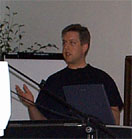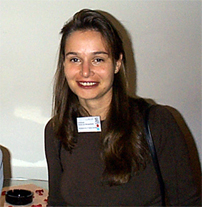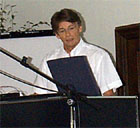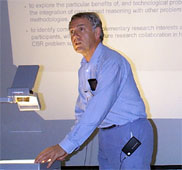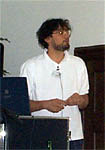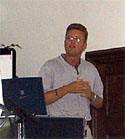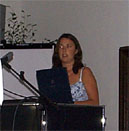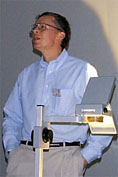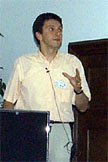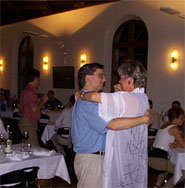ICCBR'99 Day Two
Wednesday started with the following four workshops:
These were organised by Ivo Vollrath and Sascha Schmitt. Obvioulsy I couldn't attend all the workshop so the report on them is based upon the feedback that the workshop organisers gave later in the week. |
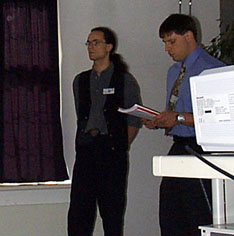 |
||||||||
| Thomas Roth-Berger reported back on Workshop 1 The Integration of Case-Based Reasoning in Business Processes. They had alloked at the interactions between a CBR system and the organisation. They recognised that a CBR system often has beneficial education effects - i.e., people learn from it. As a consequence the utility of cases my alter with time (perhaps as users get more experienced). Thus, the life span of a case will be different from the life span of the cas-base. |
|
||||||||
| Christiane Gresse von Wangenheim reported back on Workshop 2 Practical Case-Based Reasoning Strategies for Building and Maintaining Corporate Memories. They discussed current examples of CBR used for knowledge management (KM) and talked about the technical challenges. However, they recognised that motivating people to share knowledge was very important and that at the moment there is no methodology for implementing KM systems. Further information on this workshop, including the original call for papers can be found at: http://www.eps.ufsc.br/~gresse/call_ws2.html |
|
||||||||
| Alain Mille reported on Workshop 3 Formalisation of Adaptation in Case-Based Reasoning. Five papers were presented during the workshop describing different views of adaptation. Alain gave a summary of each. Overall they agreed with most of what Boi Faltings said during his keynote talk on representations, algorithms for adaptation and user adaptation. Alain said that further information on the workshop could be found at: http://www.cpr.fr/~cbrfrance/iccbr99 (however this seems to be password protected). |
|
||||||||
| Brian Lees reported on Workshop 4 Hybrid Case-Based Reasoning Systems. They had used an integration framework to characterise the hybrid systems presented during the workshop. The had also proposed intelligent agents as a means of organising hybrid CBR systems. Personally I don't think that the notion of a hybrid CBR system makes much sense if the hyrbid components are merely used within the CBR-cycle (e.g., k-nn for retrieval, GAs for adaptation) because in that sense nearly all CBR systems are hybrid systems. To me a hybrid CBR system is one that uses CBR as part of a larger problem solving strategy (e.g., CBR to daignose an illness and a heuristic planner to develop the treatment plan). If you're interested in this topic you can download a paper (201KB pdf) on this I published last year. |
|
In what is now becoming customary at CBR events
invited speakers arrive and show off their charming children. Pádraig Cunningham then
gave an invited talk on Intelligent Systems in Electronic Commerce. He
categorised two forms of e-commerce applications:
His talk was illustrated with several good and bad
examples of e-commerce systems with the point being that doing things "smart"
is almost always better for the user - and likely to be more profitable for the vendor.
The keypoint from the talk is that successful e-commerce systems will learn from user
behaviour and preferences and will exploit this knowledge to increase profits. CBR
potentially has a large role to play, not just in recommendation systems but also in
collaborative filtering systems like PTV. |
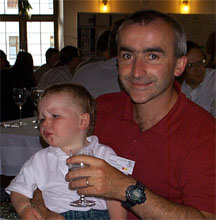 |
|
Enrico Blanzieri then presented the first of the Technical Programme papers in a session called "Retrieval". His paper Probability Based Metrics for Nearest Neighbor Classification and CBR showed a very thorough approach to the evaluation of the metrics they had developed. However, their system did not seem to perform much better than a standard naive Bayes classifier and obviously the populations size, distribution of instances and the number of classes to classify will all effect reliability. |
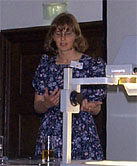 |
Stephanie Brüninghaus then presented a very
interesting paper called Bootstrapping Case-Based Development with Annotated Case
Summaries (Brüninghaus & Ashley). This seemed a very unlikely research topic,
namely using a simple ID3 algorithm combined with a thesaurus to identify concepts in
legal texts. The identified concepts can then be used as case indices. However, the
technique works remarkably well and when combined with a NLP system gets better because it
can handle negation. There's a good lessen here - try the simple techniques first, they
might just work. More about this work later.... |
|
Then followed the first of two papers from the strong research group at University College Dublin. Footprint-Based Retrieval (Smyth & McKenna) is based on the competence model of case-bases they presented at EWCBR-98. The thinking behind this is that for efficiency we don't want to check every case in a case-base for similarity but we still want to retrieve the best match. Using their competence model a case-base is pre-analysed to identify the footprint of certain key cases. Then at retrieval a first stage identifies the footprint (i.e. the broad area of the case-base where the most similar case will lie) and then a second stage retrieval exhaustively searches this subset of the case-base. Results comparing this approach to an exhaustive k-nn algorithm and a CNN (condensed nearest neighbour) algorithm showed excellent results - the efficiency of CNN with (almost) the accuracy of k-nn. |
| A debate followed this presentation with some people feeling that as processing power continually increases "what's so bad about exhaustive using brute force search", whilst others felt that there will always be good reasons why we'll need to be more efficient. If you think you need to be more efficient at retrieval I recommend you check this work out. | |
| After a coffee break we resumed to deal with Maintenance. Liz McKenna (from UCD) presented Building Compact, Competent Case Bases (Smyth & McKenna). This work followed on very neatly from Barry's talk as it also uses the competence model but this time to decide which cases to add to a case-base (i.e., only competent cases should be added). Again a thorough experimental study compared this approach to CNN and NUN (nearest unlike neighbour) algorithms with good results. Its very interesting to see a lab exploring the possibilities and implications of an idea in such a well considered way. | |
|
David Leake & David Wilson then presented a paper
called When Experience is Wrong (which wins the official ai-cbr Best Title
prize - congratulations guys!). This was an interesting exercise to define more formally
the assumptions of "regularity" that underpin CBR. This moves their research
along from the theoretical review based work on maintenance they presented at EWCBR-98.
Their position is that it is important to monitor the "regularity" of a
case-base over time as this will change. Following the metrics they define can provide
triggers to instigate maintenance activities. It's interesting to see how over the last
few years CBR research has moved on from "can we build the case-base" and
"how accurate is the retrieval" algorithm to consider issues of case-base
maintenance. Moreover, we are no approaching a situation where we can predict the accuracy
of a case-base, determine how many cases it should optimally contain and recognise when
maintenance is required. Download the paper. |
|
Mehmet Goker approached maintenance from a less theoretical viewpoint. His paper, called Integrating CBR Systems in a Corporate Environment (Göker & Roth-Berghofer) discussed the approach taken to maintain the HOMER system at DaimlerChrysler. They recognise that maintenance is as much a managerial and organisational problem as it is a technical one and this reflects that growing realisation that the CBR-cycle has 5 REs and not 4 (i.e. retrieve, reuse, revise, review & retain). Mehmet does not believe that the case review or maintenance process can be automated although it can clearly be helped by appropriate, metrics and tools. |
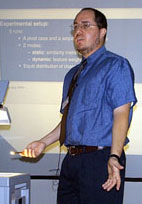 |
The session on maintenance was in my opinion the most interesting and cohesive of the sessions at ICCBR'99. Hector Muńoz-Avila closed the session with a paper called A Case Retention Policy based on Detrimental Retrieval. Hector showed that case-retention policies (CRP) are closely related to case-based maintenance (CBM). Basically good CRPs reduces CBM and vice versa. To the concepts of competence and coverage introduced by Smyth & McKenna earlier Hector added reachability. This is a measure of the cost of adapting a case to reach a solution. The argument being that if a case can be easily or cheaply adapted to reach a solution there is no need to retain the new problem/solution pair. Conversely if the adaptation cost is high then the new case should be retained, hence "retain cases when retrieval is less than successful". It is worth noting that Hector is working in a planning domain where in theory any case can be adapted to solve any problem. Maintenance is a BIG issue in CBR at the moment, with many interesting problems to solve. |
| This was all followed by the conference Gala Dinner.
Once again the food was excellent and we were entertained by a group of locals who
played a variety of instruments and gave a traditional Bavarian schuplatter dance. A certain pair of eminent CBR researchers are now holding their breath hoping that a photograph of them wearing silly hats and playing wooden spoons doesn't follow.... |
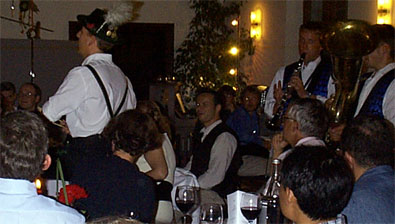 |
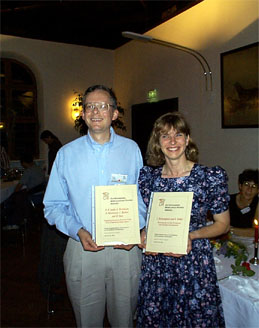 |
The serious business of the evening was
to award two prizes. The tension of which was played out to the full (and beyond) by Karl
Branting. The ICCBR'99 Best Technical Paper was awarded to Stephanie Brüninghaus for: Bootstrapping Case-Based Development with Annotated Case Summaries (Brüninghaus & Ashley) - I told you you'd hear more about this paper. She honestly was not expecting this and tears were seen. Download the paper (postscript file) The ICCBR'99 Best Application Paper was awarded to David Leake for: Integrating Information Resources: A Case Study of Engineering Design Support (Leake & Birnbaum & Hammond & Marlow & Yang). Download the paper (pdf file)) The evening was rounded off by Michel Manago telling the "true" story of the INRECA project and the entire INRECA project team singing the "INRECA song" - I bet you didn't know that European research projects all have signature tunes as well as acronyms. European CBR owes a great debt to INRECA, but the real achievement of this project is that they are all still friends afterwards! |
| The evening was finished off with dancing and of course Bavarian beer. |
|
![]()
